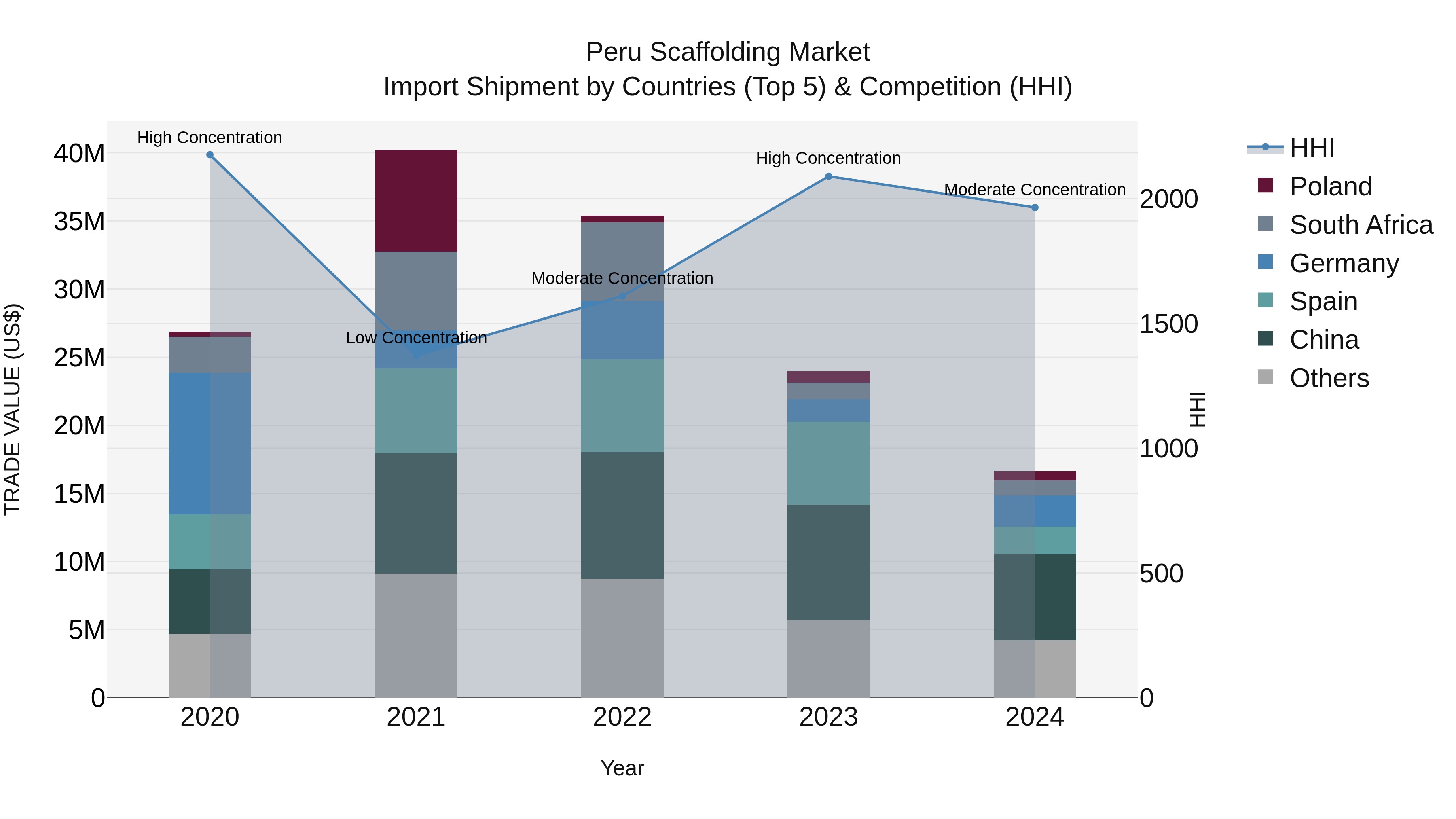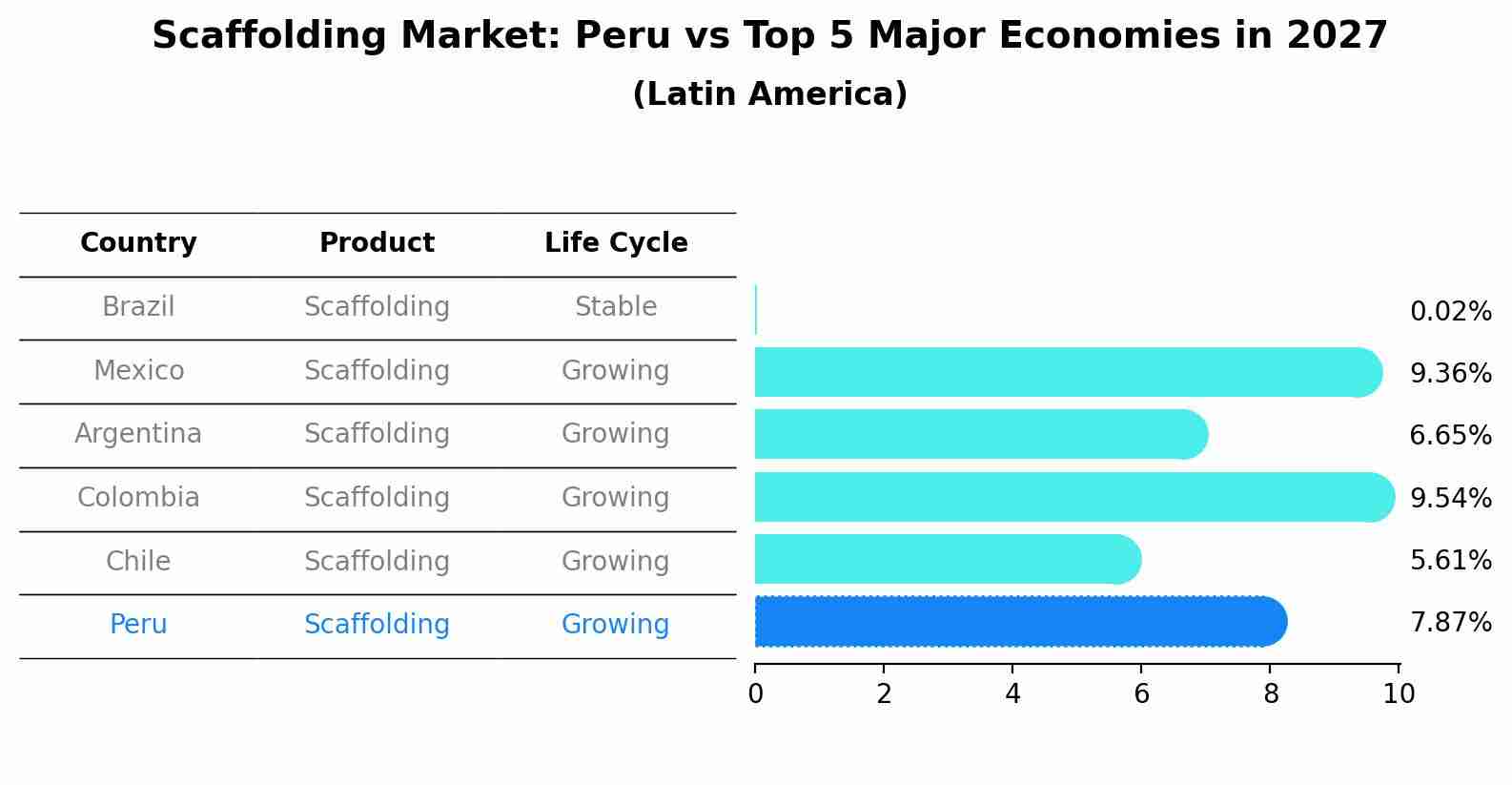Peru Scaffolding Market Outlook | Share, Analysis, Revenue, Industry, Companies, COVID-19 IMPACT, Size, Value, Forecast, Trends & Growth
| Product Code: ETC377766 | Publication Date: Aug 2022 | Updated Date: Nov 2025 | Product Type: Market Research Report | |
| Publisher: 6Wresearch | Author: Summon Dutta | No. of Pages: 75 | No. of Figures: 35 | No. of Tables: 20 |
Peru Scaffolding Market Top 5 Importing Countries and Market Competition (HHI) Analysis
Peru`s scaffolding import shipments in 2024 saw a shift in concentration from high to moderate, with top exporting countries being China, Germany, Spain, Austria, and South Africa. The industry experienced a significant decline in both CAGR (-11.32%) and growth rate (-30.64%) from 2023 to 2024. This indicates a challenging market environment, possibly influenced by various factors such as economic conditions, trade policies, or industry dynamics. Monitoring these trends and understanding the changing competitive landscape will be crucial for stakeholders in the scaffolding import sector.

Scaffolding Market: Peru vs Top 5 Major Economies in 2027 (Latin America)
The Scaffolding market in Peru is projected to grow at a growing growth rate of 7.87% by 2027, highlighting the country's increasing focus on advanced technologies within the Latin America region, where Brazil holds the dominant position, followed closely by Mexico, Argentina, Colombia and Chile, shaping overall regional demand.

Peru Scaffolding Market Synopsis
The Peru scaffolding market is witnessing steady growth driven by increasing construction activities across the country. The demand for scaffolding is predominantly fueled by infrastructure development projects, residential construction, and commercial projects in sectors such as oil and gas, mining, and energy. The market is characterized by the presence of both domestic and international scaffolding manufacturers, providing a wide range of products and services to meet the diverse needs of the construction industry. Key factors influencing market growth include stringent safety regulations, technological advancements in scaffolding materials, and the focus on sustainable construction practices. As the construction industry continues to expand in Peru, the scaffolding market is expected to experience further growth, presenting opportunities for market players to innovate and expand their presence in the region.
Peru Scaffolding Market Trends
The Peru scaffolding market is experiencing a growth trend driven by increasing construction activities in the country. Demand for scaffolding is rising due to infrastructure development projects, residential construction, and industrial expansion. The market is also witnessing a shift towards safer and more efficient scaffolding solutions, leading to increased adoption of advanced materials and technologies. Sustainable practices are becoming more important, prompting companies to invest in eco-friendly scaffolding options. Additionally, the market is seeing a growing preference for rental scaffolding services among construction firms to reduce costs and improve flexibility. Overall, the Peru scaffolding market is expected to continue its positive trajectory in the coming years fueled by ongoing construction projects and the focus on safety and sustainability.
Peru Scaffolding Market Challenges
In the Peru scaffolding market, some of the key challenges include the presence of a large informal sector operating without adherence to safety standards, leading to potential risks for workers and project delays. Additionally, fluctuating economic conditions and currency exchange rates can impact the pricing and availability of scaffolding materials, affecting project budgets and timelines. Limited awareness about the importance of using quality scaffolding equipment and the lack of stringent regulations to enforce safety standards further compound the challenges faced by industry players in Peru. To succeed in this market, companies need to prioritize safety measures, invest in training programs, and establish strong partnerships with suppliers to ensure the availability of high-quality scaffolding materials despite market fluctuations.
Peru Scaffolding Market Investment Opportunities
The Peru scaffolding market presents promising investment opportunities due to the country`s growing construction sector. With numerous infrastructure projects underway and a strong demand for commercial and residential buildings, the need for scaffolding services is expected to increase. Investors can consider entering the market by investing in scaffolding rental companies, manufacturing firms, or providing scaffolding solutions to construction projects. Additionally, technological advancements in scaffolding materials and safety regulations in Peru create opportunities for innovative and sustainable solutions. By tapping into this market, investors can benefit from the construction boom in Peru and contribute to the development of the industry.
Jordan Agar Market Government Policies
Government policies related to the Peru scaffolding market focus on ensuring safety standards and regulations are met to protect workers and the public. The government requires scaffolding companies to adhere to specific guidelines and obtain necessary permits before erecting scaffolding structures. Additionally, there are regulations in place to monitor the quality of materials used in scaffolding construction to prevent accidents and ensure structural stability. Compliance with these policies is essential for companies operating in the scaffolding market in Peru to avoid fines and legal consequences. The government also encourages the adoption of sustainable practices in scaffolding construction to minimize environmental impact. Overall, the government plays a crucial role in regulating and overseeing the Peru scaffolding market to promote safety, quality, and sustainability in the industry.
Peru Scaffolding Market Future Outlook
The Peru scaffolding market is expected to experience steady growth in the coming years, driven by increasing construction activities in the country. The government`s focus on infrastructure development, including the construction of roads, bridges, and commercial buildings, is creating a strong demand for scaffolding solutions. Additionally, the growth of the oil and gas industry in Peru is expected to further boost the demand for scaffolding in industrial projects. The market is also witnessing a shift towards more advanced and durable scaffolding systems to ensure safety and efficiency on construction sites. Overall, the Peru scaffolding market is projected to expand as the construction sector continues to grow, presenting opportunities for both local and international scaffolding companies to capitalize on this trend.
Key Highlights of the Report:
- Peru Scaffolding Market Outlook
- Market Size of Peru Scaffolding Market, 2021
- Forecast of Peru Scaffolding Market, 2031
- Historical Data and Forecast of Peru Scaffolding Revenues & Volume for the Period 2018 - 2031
- Peru Scaffolding Market Trend Evolution
- Peru Scaffolding Market Drivers and Challenges
- Peru Scaffolding Price Trends
- Peru Scaffolding Porter's Five Forces
- Peru Scaffolding Industry Life Cycle
- Historical Data and Forecast of Peru Scaffolding Market Revenues & Volume By Type for the Period 2018 - 2031
- Historical Data and Forecast of Peru Scaffolding Market Revenues & Volume By Supported Scaffolding for the Period 2018 - 2031
- Historical Data and Forecast of Peru Scaffolding Market Revenues & Volume By Suspended Scaffolding for the Period 2018 - 2031
- Historical Data and Forecast of Peru Scaffolding Market Revenues & Volume By Rolling Scaffolding for the Period 2018 - 2031
- Historical Data and Forecast of Peru Scaffolding Market Revenues & Volume By Material for the Period 2018 - 2031
- Historical Data and Forecast of Peru Scaffolding Market Revenues & Volume By Aluminum for the Period 2018 - 2031
- Historical Data and Forecast of Peru Scaffolding Market Revenues & Volume By Wood for the Period 2018 - 2031
- Historical Data and Forecast of Peru Scaffolding Market Revenues & Volume By Steel for the Period 2018 - 2031
- Historical Data and Forecast of Peru Scaffolding Market Revenues & Volume By End User for the Period 2018 - 2031
- Historical Data and Forecast of Peru Scaffolding Market Revenues & Volume By Residential for the Period 2018 - 2031
- Historical Data and Forecast of Peru Scaffolding Market Revenues & Volume By Commercial for the Period 2018 - 2031
- Historical Data and Forecast of Peru Scaffolding Market Revenues & Volume By Industrial for the Period 2018 - 2031
- Peru Scaffolding Import Export Trade Statistics
- Market Opportunity Assessment By Type
- Market Opportunity Assessment By Material
- Market Opportunity Assessment By End User
- Peru Scaffolding Top Companies Market Share
- Peru Scaffolding Competitive Benchmarking By Technical and Operational Parameters
- Peru Scaffolding Company Profiles
- Peru Scaffolding Key Strategic Recommendations
Frequently Asked Questions About the Market Study (FAQs):
- Single User License$ 1,995
- Department License$ 2,400
- Site License$ 3,120
- Global License$ 3,795
Search
Thought Leadership and Analyst Meet
Our Clients
Related Reports
- Canada Oil and Gas Market (2026-2032) | Share, Segmentation, Value, Industry, Trends, Forecast, Analysis, Size & Revenue, Growth, Competitive Landscape, Outlook, Companies
- Germany Breakfast Food Market (2026-2032) | Industry, Share, Growth, Size, Companies, Value, Analysis, Revenue, Trends, Forecast & Outlook
- Australia Briquette Market (2025-2031) | Growth, Size, Revenue, Forecast, Analysis, Trends, Value, Share, Industry & Companies
- Vietnam System Integrator Market (2025-2031) | Size, Companies, Analysis, Industry, Value, Forecast, Growth, Trends, Revenue & Share
- ASEAN and Thailand Brain Health Supplements Market (2025-2031) | Strategy, Consumer Insights, Analysis, Investment Trends, Opportunities, Growth, Size, Share, Industry, Revenue, Segments, Value, Segmentation, Supply, Forecast, Restraints, Outlook, Competition, Drivers, Trends, Demand, Pricing Analysis, Competitive, Strategic Insights, Companies, Challenges
- ASEAN Bearings Market (2025-2031) | Strategy, Consumer Insights, Analysis, Investment Trends, Opportunities, Growth, Size, Share, Industry, Revenue, Segments, Value, Segmentation, Supply, Forecast, Restraints, Outlook, Competition, Drivers, Trends, Demand, Pricing Analysis, Competitive, Strategic Insights, Companies, Challenges
- Europe Flooring Market (2025-2031) | Outlook, Share, Industry, Trends, Forecast, Companies, Revenue, Size, Analysis, Growth & Value
- Saudi Arabia Manlift Market (2025-2031) | Outlook, Size, Growth, Trends, Companies, Industry, Revenue, Value, Share, Forecast & Analysis
- Uganda Excavator, Crane, and Wheel Loaders Market (2025-2031) | Strategy, Consumer Insights, Analysis, Investment Trends, Opportunities, Growth, Size, Share, Industry, Revenue, Segments, Value, Segmentation, Supply, Forecast, Restraints, Outlook, Competition, Drivers, Trends, Demand, Pricing Analysis, Competitive, Strategic Insights, Companies, Challenges
- Rwanda Excavator, Crane, and Wheel Loaders Market (2025-2031) | Strategy, Consumer Insights, Analysis, Investment Trends, Opportunities, Growth, Size, Share, Industry, Revenue, Segments, Value, Segmentation, Supply, Forecast, Restraints, Outlook, Competition, Drivers, Trends, Demand, Pricing Analysis, Competitive, Strategic Insights, Companies, Challenges
Industry Events and Analyst Meet
Whitepaper
- Middle East & Africa Commercial Security Market Click here to view more.
- Middle East & Africa Fire Safety Systems & Equipment Market Click here to view more.
- GCC Drone Market Click here to view more.
- Middle East Lighting Fixture Market Click here to view more.
- GCC Physical & Perimeter Security Market Click here to view more.
6WResearch In News
- Doha a strategic location for EV manufacturing hub: IPA Qatar
- Demand for luxury TVs surging in the GCC, says Samsung
- Empowering Growth: The Thriving Journey of Bangladesh’s Cable Industry
- Demand for luxury TVs surging in the GCC, says Samsung
- Video call with a traditional healer? Once unthinkable, it’s now common in South Africa
- Intelligent Buildings To Smooth GCC’s Path To Net Zero


















